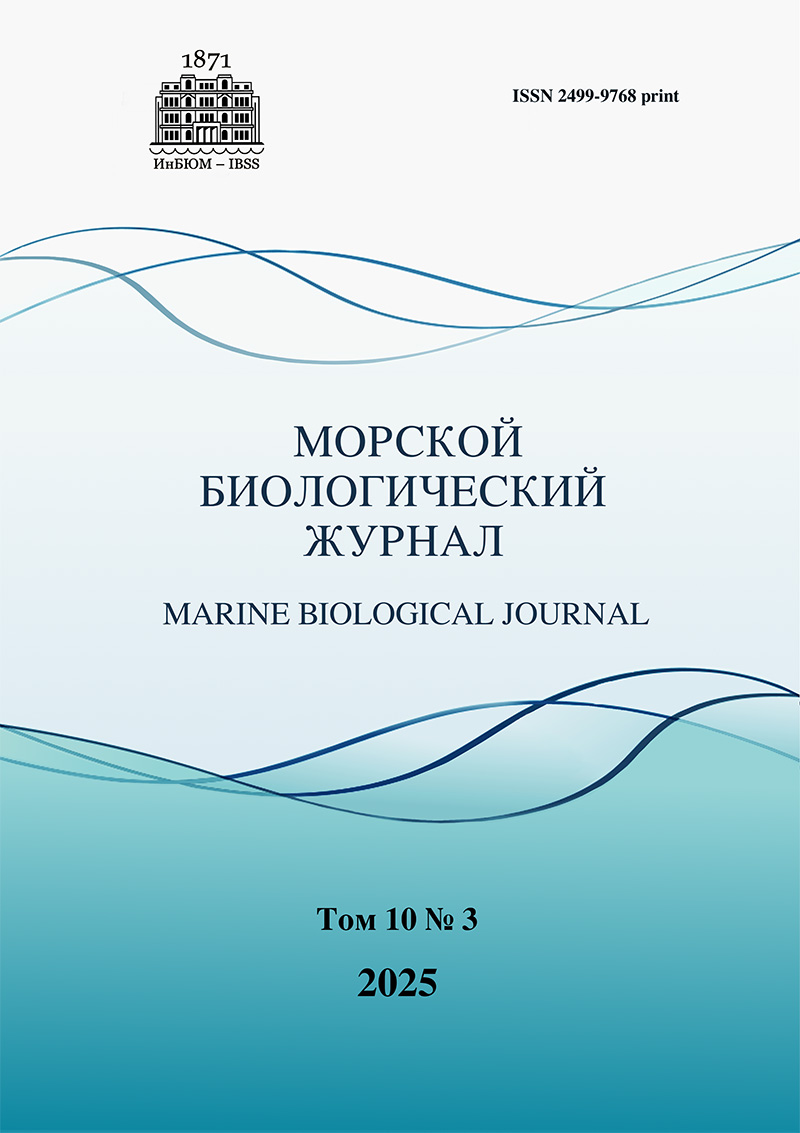The effect of heavy metals on the growth rate of microalgae Heterosigma akashiwo, Alexandrium affine, and Prorocentrum foraminosum
##plugins.themes.ibsscustom.article.main##
##plugins.themes.ibsscustom.article.details##
Abstract
A rise in the frequency of harmful algal blooms is associated with increasing environmental pollution, in particular with a gain in heavy metal content in waters. The aim of the study was to assess the effect of heavy metals on the growth rate of microalgae causing such blooms. The effect of heavy metals on the growth rate of microalgae Heterosigma akashiwo, Alexandrium affine, and Prorocentrum foraminosum was investigated: cadmium Cd2+, nickel Ni2+, and lead Pb2+ at concentrations of 10 and 20 μg·L−1, as well as zinc Zn2+ and iron Fe3+ at 50 and 100 μg·L−1. The evaluation was carried out on the third and seventh days of the experiment. These heavy metals were found to affect all investigated algae species. On the third day, the growth rate of H. akashiwo increased with the addition of Cd2+, Pb2+, Ni2+, and Fe3+; the growth was suppressed with the addition of Zn2+. On the seventh day, the microalga inhibition was recorded at 10 and 20 μg·L−1 of Cd2+, 10 μg·L−1 of Pb2+ and Ni2+, and 100 μg·L−1 of Zn2+. H. akashiwo stimulation occurred at 20 μg·L−1 of Pb2+ and Ni2+, as well as at 50 and 100 μg·L−1 of Fe3+. The growth rate of A. affine on the third day rose at 20 μg·L−1 of Cd2+, 10 and 20 μg·L−1 of Pb2+ and Ni2+, and 100 μg·L−1 of Fe2+ and Zn2+. On the seventh day, the growth rate dropped because of the negative effect of 10 and 20 μg·L−1 of Cd2+ and Pb2+, as well as 20 μg·L−1 of Ni2+. Stimulation of A. affine growth was registered at 10 μg·L−1 of Ni2+ and at both concentrations of Fe3+ and Zn2+. P. foraminosum was the least resistant to heavy metals. Its growth rate decreased when exposed to all toxicants, except for Fe3+: in this case, stimulation of the microalga growth occurred on the seventh day of the experiment.
Authors
References
Качество морских вод по гидрохимическим показателям. Ежегодник 2020 / под ред. А. Н. Коршенко. Москва : Наука, 2020. 200 с. [Marine Water Pollution. Annual Report 2020 / A. Korshenko (Ed.). Moscow : Nauka, 2020, 200 p. (in Russ.)]
Руководство по определению методом биотестирования токсичности вод, донных отложений, загрязняющих веществ и буровых растворов / Министерство природных ресурсов Российской Федерации. Москва : РЭФИА : НИА-Природа, 2002. [60] с. [Rukovodstvo po opredeleniyu metodom biotestirovaniya toksichnosti vod, donnykh otlozhenii, zagryaznyayushchikh veshchestv i burovykh rastvorov / Ministerstvo prirodnykh resursov Rossiiskoi Federatsii. Moscow : REFIA : NIA-Priroda, 2002, [60] p. (in Russ.)]
Ahmadi Z. B., Taherizadeh M. R., Zadi M. Y. Effects of different concentrations of lead on growth, photosynthetic pigmentation and protein in micro alga Isochrysis galbana. Journal of Oceanography, 2021, vol. 12, iss. 46, pp. 109–116.
Anderson D. M., Alpermann T. J., Cembella A. D., Collos Y., Masseret E., Montresor M. The globally distributed genus Alexandrium: Multifaceted roles in marine ecosystems and impacts on human health. Harmful Algae, 2012, vol. 14, pp. 10–35. https://doi.org/10.1016/j.hal.2011.10.012
Calabrese E. J., Mattson M. P. Hormesis provides a generalized quantitative estimate of biological plasticity. Journal of Cell Communication and Signaling, 2011, vol. 5, iss. 1, pp. 25–38. https://doi.org/10.1007/s12079-011-0119-1
Cedergreen N., Streibig J. C., Kudsk P., Mathiassen S. K., Duke S. O. The occurrence of hormesis in plants and algae. Dose-Response, 2007, vol. 5, iss. 2, pp. 150–162. https://doi.org/10.2203/dose-response.06-008.Cedergreen
Dursun F., Taş S., Koray T. Spring bloom of the raphidophycean Heterosigma akashiwo in the Golden Horn Estuary at the northeast of Sea of Marmara. Ege Journal of Fisheries and Aquatic Sciences, 2016, vol. 33, iss. 3, pp. 201–207. https://doi.org/10.12714/egejfas.2016.33.3.03
Guillard R. R. L., Ryther J. H. Studies of marine planktonic diatoms. I. Cyclotella nana Hustedt, and Detonula confervacea (Cleve) Gran. Canadian Journal of Microbiology, 1962, vol. 8, no. 2, pp. 229–239. https://doi.org/10.1139/m62-029
Gissi F., Adams M. S., King C. K., Jolley D. F. A robust bioassay to assess the toxicity of metals to the Antarctic marine microalga Phaeocystis antarctica. Environmental Toxicology and Chemistry, 2015, vol. 34, iss. 7, pp. 1578–1587. https://doi.org/10.1002/etc.2949
Heisler J., Glibert P. M., Burkholder J. M., Anderson D. M., Cochlan W., Dennison W. C., Dortch Q., Gobler C. J., Heil C. A., Humphries E., Lewitus A., Magnien R., Marshall H. G., Sellner K., Stockwell D. A., Stoecker D. K., Suddleson M. Eutrophication and harmful algal blooms: A scientific consensus. Harmful Algae, 2008, vol. 8, iss. 1, pp. 3–13. https://doi.org/10.1016/j.hal.2008.08.006
Li M., Zhang F., Glibert P. M. Seasonal life strategy of Prorocentrum minimum in Chesapeake Bay, USA: Validation of the role of physical transport using a coupled physical–biogeochemical–harmful algal bloom model. Limnology and Oceanography, 2021, vol. 66, iss. 11, pp. 3873–3886. https://doi.org/10.1002/lno.11925
Martínez-Ruiz E. B., Martínez-Jeronimo F. Nickel has biochemical, physiological, and structural effects on the green microalga Ankistrodesmus falcatus: An integrative study. Aquatic Toxicology, 2015, vol. 169, pp. 27–36. https://doi.org/10.1016/j.aquatox.2015.10.007
Nagajoti P. C., Lee K. D., Sreekanth T. V. M. Heavy metals, occurrence and toxicity for plants: A review. Environmental Chemistry Letters, 2010, vol. 8, iss. 3, pp. 199–216. https://doi.org/10.1007/s10311-010-0297-8
Shin H. H., Li Z., Mertens K. N., Seo M. H., Gu H., Lim W. A., Yoon Y. H., Soh H. Y., Matsuoka K. Prorocentrum shikokuense Hada and P. donghaiense Lu are junior synonyms of P. obtusidens Schiller, but not of P. dentatum Stein (Prorocentrales, Dinophyceae). Harmful Algae, 2019, vol. 89, art. no. 101686 (14 p.). https://doi.org/10.1016/j.hal.2019.101686


 Google Scholar
Google Scholar



